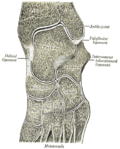Metatarsal bones
Metatarsal Bones
The metatarsal bones are a group of five long bones in the foot, located between the tarsal bones of the hind- and mid-foot and the phalanges of the toes. Lacking individual names, they are numbered from the medial side (side of big toe): the first, second, third, fourth, and fifth metatarsal (often depicted with Roman numerals).
Structure[edit]
Each metatarsal bone is a long bone, being broad and concave at the proximal end, tapering down to the distal end. The body of the metatarsal is prismoid in form, tapers gradually from the tarsal to the phalangeal extremity, and is curved longitudinally, so as to be concave below, slightly convex above.
First Metatarsal[edit]
The first metatarsal bone is the thickest and shortest of the metatarsal bones. It is designed to bear more weight than the other metatarsals, and its unique structure is adapted to take on this role.
Second to Fifth Metatarsals[edit]
The second metatarsal bone, third metatarsal bone, fourth metatarsal bone, and fifth metatarsal bone are all long bones, each with a base, shaft, and head. The base is the part of the bone that is closest to the ankle, the shaft is the long, slender part of the bone, and the head is at the end of the bone that is closest to the toe.
Function[edit]
The metatarsal bones are crucial for balance and propulsion during walking and running. They work together with the tarsal bones to provide a stable platform for the body, and with the phalanges to provide leverage for the toes.
Clinical Significance[edit]
Injuries to the metatarsal bones are common and can include fractures, dislocations, and stress fractures. These injuries are often caused by direct trauma, overuse, or systemic diseases such as osteoporosis.
See Also[edit]
References[edit]
<references group="" responsive="1"></references>
Metatarsal_bones[edit]
-
Metatarsal bones superior view
-
Gray's Anatomy illustration of the metatarsus
-
Diagram of the foot bones
-
Gray's Anatomy illustration of the metatarsus
-
Gray's Anatomy illustration of the metatarsus
-
Fracture at the base of the 5th metatarsal
-
X-ray of a foot
-
Gray's Anatomy illustration of the metatarsus
-
Gray's Anatomy illustration of the foot
-
Slide showing metatarsal bones
-
Metatarsal guard
Ad. Transform your life with W8MD's Budget GLP-1 injections from $75


W8MD offers a medical weight loss program to lose weight in Philadelphia. Our physician-supervised medical weight loss provides:
- Weight loss injections in NYC (generic and brand names):
- Zepbound / Mounjaro, Wegovy / Ozempic, Saxenda
- Most insurances accepted or discounted self-pay rates. We will obtain insurance prior authorizations if needed.
- Generic GLP1 weight loss injections from $75 for the starting dose.
- Also offer prescription weight loss medications including Phentermine, Qsymia, Diethylpropion, Contrave etc.
NYC weight loss doctor appointmentsNYC weight loss doctor appointments
Start your NYC weight loss journey today at our NYC medical weight loss and Philadelphia medical weight loss clinics.
- Call 718-946-5500 to lose weight in NYC or for medical weight loss in Philadelphia 215-676-2334.
- Tags:NYC medical weight loss, Philadelphia lose weight Zepbound NYC, Budget GLP1 weight loss injections, Wegovy Philadelphia, Wegovy NYC, Philadelphia medical weight loss, Brookly weight loss and Wegovy NYC
|
WikiMD's Wellness Encyclopedia |
| Let Food Be Thy Medicine Medicine Thy Food - Hippocrates |
Medical Disclaimer: WikiMD is not a substitute for professional medical advice. The information on WikiMD is provided as an information resource only, may be incorrect, outdated or misleading, and is not to be used or relied on for any diagnostic or treatment purposes. Please consult your health care provider before making any healthcare decisions or for guidance about a specific medical condition. WikiMD expressly disclaims responsibility, and shall have no liability, for any damages, loss, injury, or liability whatsoever suffered as a result of your reliance on the information contained in this site. By visiting this site you agree to the foregoing terms and conditions, which may from time to time be changed or supplemented by WikiMD. If you do not agree to the foregoing terms and conditions, you should not enter or use this site. See full disclaimer.
Credits:Most images are courtesy of Wikimedia commons, and templates, categories Wikipedia, licensed under CC BY SA or similar.
Translate this page: - East Asian
中文,
日本,
한국어,
South Asian
हिन्दी,
தமிழ்,
తెలుగు,
Urdu,
ಕನ್ನಡ,
Southeast Asian
Indonesian,
Vietnamese,
Thai,
မြန်မာဘာသာ,
বাংলা
European
español,
Deutsch,
français,
Greek,
português do Brasil,
polski,
română,
русский,
Nederlands,
norsk,
svenska,
suomi,
Italian
Middle Eastern & African
عربى,
Turkish,
Persian,
Hebrew,
Afrikaans,
isiZulu,
Kiswahili,
Other
Bulgarian,
Hungarian,
Czech,
Swedish,
മലയാളം,
मराठी,
ਪੰਜਾਬੀ,
ગુજરાતી,
Portuguese,
Ukrainian









